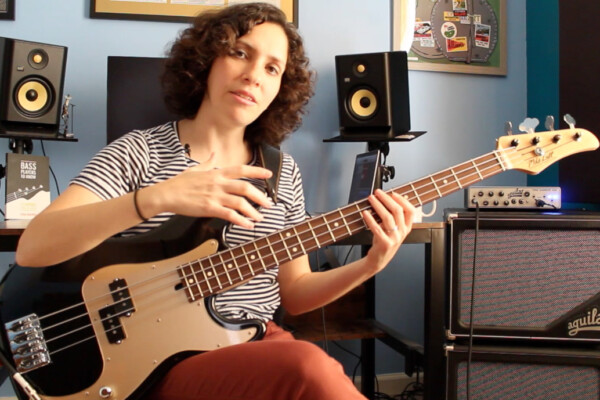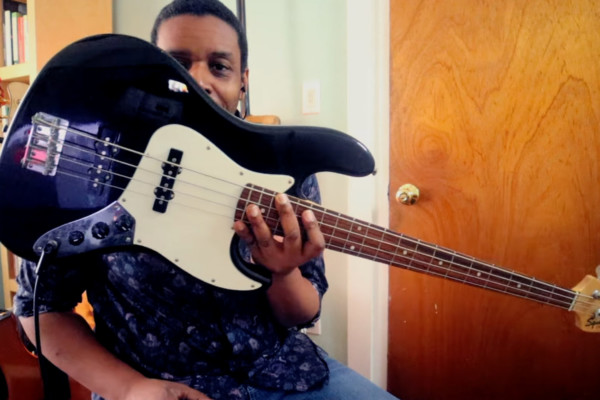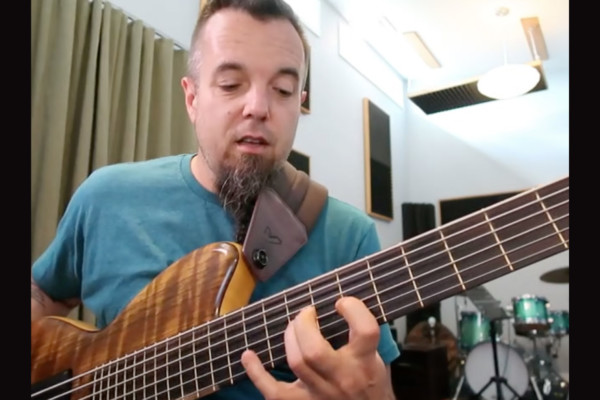Getting to Know Your Bass: All About the Neck

In part one of Getting to Know Your Bass, we discussed the importance of knowing what the tone knobs do on your instrument.
Now, we’ll continue our discussion by learning about how your instrument’s neck influences where, what and how you play. We’ll begin with scale length and how it may impact your tone or musical choices. Then, we’ll get into playing and the importance of knowing where to play notes on the neck in order to get a certain tone. Ultimately, not all A’s are created equal, and discovering how the notes sound depending upon where you play them can give you new tone or position options.
Whenever we’re on the hunt for a new instrument, we’re likely to keep a few things in mind: comfort, tone, aesthetics, budget, usefulness, and other personal preferences (such as number of strings). Scale length is actually a sticking point for me since it impacts both tone and fret spacing.
For some reason, whenever I step into a music store to check out basses, someone ushers me in the direction of the only short-scale bass in the shop. Ok, I get it, I’m short. Although I appreciate the sales associate’s help, I’ve always had better luck with the standard 34” scale basses because I prefer the way they sound and it’s more comfortable to play.
While there are some great sounding short-scale basses here and there, the depth and body of the low E may be compromised since there is less string tension. The open strings may sound a bit boomier or less “ballsy” compared to a standard neck. That’s not a hard and steadfast rule for all short scale basses, but it’s something to listen for while you’re trying out different axes. Furthermore, if you’re a player that’s used to the way a standard or longer scale neck plays, your hands may have trouble adjusting to where the frets are on the instrument. You may fumble at first, but then you may also find it easier to play technically challenging lines due to the smaller scale.
Similarly, a longer scale neck may provide greater definition and clarity to the lower notes, especially if you’re playing a 5 string. If you have a 34” scale 5-string bass, you may find that the low B can get a little bit muddy or indistinct. Believe it or not, that added inch of scale length makes a huge impact on the tone of the notes. If I’m doing a gig that calls for me to play the low B a lot, I’ll use the 35” scale bass, knowing that the instrument will better lend itself to the gig. If I’m playing a 34” scale 5-string, I’ll tread lightly on the B string since I’m not as confident in the tone of the notes. I’ll go out of my way to play the E, F, F#, and G on the E string instead of the B, simply because the notes will have greater character.
There are many other factors involving the neck of your instrument that will impact your tone, most notably the woods used for the neck and fretboard. This is a huge subject in and of itself, but since it doesn’t directly impact your playing, we’ll save that topic for another time.
And now to get into playing…
One of the advantages of playing a fretted instrument, such as bass or guitar, is that you can play the same notes of the same register in a few different places. On other instruments, such as piano, there may be a lot of A’s, but they’re all in different registers (or octaves). On the bass, you may have 2-3 options of where to play the same note (depending on the number of strings that you have and the register of the note that you’re playing). The more you explore your instrument, the more you’ll hear the differences in the tone of the notes. For instance, try playing your open A versus your fretted A (5th fret of your E string). The tone of the fretted note is quite different and you may find that you have greater control over sustain and note duration of the fretted note. Then, if you want to play the octave of that A, you have a couple of options. You can play the 12th fret on the A string, which will have a rounder, warmer tone, or the 7th fret of the D string, which will be punchier.
A cool exercise to do in order to get better acquainted with the tone of the notes on your bass is to play the same bass line or scale slowly in two different places. Let’s say you play a C major scale. Start on the 3rd fret of your A string and then start on the 8th fret of your E string and try to describe the subtle differences in tone. To relate it to “on the job” playing, listen to different records and try to pick out where on the instrument the bass line is played. If you listen to some modern country/rock, you’ll hear a lot of playing on the higher parts of the neck, especially for fills or parts of the song that have heightened dynamics.
Not only do notes sound different depending upon where on the neck you play them, but they can be played in different ways. It’s easier to implement certain techniques, such as bending strings or playing chords, higher up on the neck and on the thinner strings. Changing positions from the lower portion of your neck (below the 5th fret), to higher up will let you play long slides into notes and allow for different fingering patterns. Understanding the options you have for playing in different places on the instrument will help you influence the dynamics of the band and will lessen your reliance on muscle memory and “go to fills” that you may have in your repertoire.
In the next part of this series, we’ll delve into your bass’s action and how that may or may not allow for the use of certain techniques. If you’ve ever wondered why tapping is particularly difficult on your Fender P-bass, this will be the column for you!
Photo by 96dpi
Ryan Madora is a professional bass player, author, and educator living in Nashville, TN. In addition to touring and session work, she teaches private lessons and masterclasses to students of all levels. Visit her website to learn more!




Another informative article Ryan!
Great Article Ryan! A subject seldom discussed. I feel like the “Indiana Jones” of bass – always in search of the best tone…
probably the coolest thing i have ever heard.
Great article Ryan! Being a 4 string player, I’m most at home on a 34″ scale bass too. I’ve had my share of 5 and 6 string 35″ basses and, while I love the solid tone, I just don’t feel as comfortable. I also have a 30″ custom that’s a lot of fun to play and it definitely has it’s place.
Of all the factors involved in picking out a new bass, I personally find the feel of the neck to be most important (given that it’s good quality and made of the tone woods I prefer).
Well done and informative.
having played mostly 5 and 4 string bass for the last dozen or so years, this last few months i have started on 6 and 7 string so now i have 35, 34 and 30″ fretless to get my hands n mind around. it keeps me from having idle hands
Rather than informational, this article seems to just be about the authors preferences and opinions.